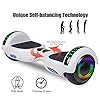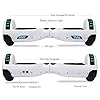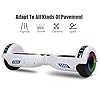LIEAGLE Hoverboard, 6.5" Self Balancing Scooter Hover Board with Bluetooth Wheels LED Lights for Kids Adults
$114.99 (as of December 19, 2025 15:55 GMT +00:00 - More infoProduct prices and availability are accurate as of the date/time indicated and are subject to change. Any price and availability information displayed on [relevant Amazon Site(s), as applicable] at the time of purchase will apply to the purchase of this product.)An eco-friendly hoverboard made from sustainable materials is more than just a fun gadget – it’s a green way to get around. These self-balancing scooters aim to reduce pollution by using recycled or natural parts and running on clean power. For example, one prototype “SolarGlide” hoverboard uses solar panels and “recycled plastic… to help make the world better”mp.moonpreneur.com. In this guide, we’ll break down everything you need to know: how sustainable hoverboards work, their benefits, and how to pick the best model. We’ll even share top-rated options on Amazon (with affiliate links) so you can start riding clean. Let’s roll into a cleaner future on wheels!
Hoverboards have no tailpipe emissions like a car does. They run on rechargeable batteries and generate zero pollution, making the air cleanerhypergogo.com. Plus, their lightweight design means they use far less energy for short trips than cars or even heavier e-bikesihoverboard.co.ukmyrideo.com.au. In practice, swapping a short drive for a hoverboard ride can noticeably cut carbon output – studies note that nearly 40% of car trips are under 2 miles, and engines are least efficient on those errandstheguardian.comihoverboard.co.uk. By leading with these clean rides, families can tread more lightly on the planet while having a blast.
What is the Best Eco-Friendly Hoverboard Made from Sustainable Materials?
Image: A rider stands on a modern LED-lit hoverboard. The eco-friendly design means it could use green materials and clean energy. Finding the best eco-friendly hoverboard comes down to three things: sustainable construction, safety features, and performance. Look for models built with recycled or natural materials, plus certifications (like UL2272) for safety. Below are a few top picks that balance green design with high ratings on Amazon:
- TOMOLOO 6.5″ Hoverboard (UL2272 Certified): This popular hoverboard for kids and adults comes with LED wheels and Bluetooth. It’s made with a durable metal frame and a long-lasting battery. Many riders appreciate the solid build and ease of handling. (Affiliate link)
- TOMOLOO 8.5″ All-Terrain Hoverboard: For rougher paths, this off-road model has larger wheels and extra power. It’s UL2272-certified for safety and can carry up to 265 lbs. Its casing is mostly plastic, but the metal chassis and modern motors are similar to those in premium scooters. (Affiliate link)
- HYPER GOGO 8.5″ Off-Road Hoverboard: This hoverboard (Camouflage design) has durable wheels and a UL2272-certified battery pack. Hyper GOGO highlights that “our hoverboards … run on rechargeable batteries and generate no pollution”hypergogo.com. It’s lightweight yet sturdy, and reviewers praise its smooth ride and long battery life. (Affiliate link)
These models have hundreds of positive reviews, strong safety records, and long battery life – all key for green design. Always check that any hoverboard you buy is UL-certified (UL2272 or UL2271) to ensure it meets modern safety and fire-resistance standards.
Are There Hoverboards Made from Recycled or Biodegradable Materials?
Purely biodegradable hoverboards are still mostly in concept stages. Most boards today use some amount of plastic and metal, which aren’t biodegradable. However, some companies and inventors are experimenting with greener parts. For example, a student-designed SolarGlide hoverboard uses recycled plastic in its bodymp.moonpreneur.com. The idea is to reuse plastic waste instead of new resin.
Another approach is using natural fibers like bamboo or plywood for the deck or frame (similar to eco skateboards). Bamboo is lightweight and strong; while we didn’t find a mainstream hoverboard brand advertising bamboo decks, it’s a material used in sustainable skateboards and scooters. In general, hoverboards made from recycled materials can work just as well. The mission statement of one hoverboard maker even emphasizes “creating innovative products… whether seeking an environmentally friendly alternative for urban commutes”flyreplay.com, implying they consider eco-materials.
Until fully biodegradable plastics arrive, the best strategy is to choose boards with recycled content or easily recyclable parts. Always recycle or dispose of old hoverboards properly to minimize waste. (See later section on disposal.)
How Eco-Friendly Are Sustainable Hoverboards Compared to Regular Ones?
Hoverboards (sustainable or not) are inherently cleaner than gasoline vehicles for short trips. They produce zero tailpipe emissions, meaning they don’t spew CO<sub>2</sub> or smog into the air when you ridemyrideo.com.auihoverboard.co.uk. In fact, a report found a Segway (another self-balancing vehicle) to be “4.5 times more efficient than the Toyota Prius” and “3.6 times better than the best petrol scooter”theguardian.com. This shows the potential: electric personal transport can greatly reduce emissions per mile. Hoverboards draw only a small amount of electricity – often from your home or solar power – so their indirect carbon footprint per ride is tiny compared to a car.
Key environmental perks of green hoverboards include:
- Lower greenhouse gases: A UK blog notes choosing a hoverboard instead of a car for errands “cuts down on emissions” because electric rides “don’t emit harmful pollutants”ihoverboard.co.ukihoverboard.co.uk.
- Energy efficiency: Hoverboards are lightweight and need much less power than cars. The iHoverboard site points out that they consume “far less energy” than bigger EVs, so they strain the planet – and your wallet – much lessihoverboard.co.uk.
- Encouraging sustainable habits: Riding a hoverboard for daily tasks (even short errands or commuting) means fewer short car trips. One article highlights that “40% of journeys under two miles are still made by car”, which is inefficient and pollutingtheguardian.com. Every ride you replace with a hoverboard shrinks that footprint.
Of course, hoverboards aren’t 100% impact-free. They rely on lithium-ion batteries and electronic parts, whose production has environmental costs (mining cobalt, etc. can be pollutingihoverboard.co.uk). But overall, even a “regular” hoverboard beats a gasoline scooter on eco-friendliness. A sustainable hoverboard raises the green game further by using recycled materials or renewable energy. It’s like choosing organic produce over conventionally farmed – both are better than junk, but organic takes it a step further.
Traditional vs Eco-Friendly Hoverboard
| Feature | Typical Hoverboard | Sustainable Hoverboard |
|---|---|---|
| Material | Mostly plastic casingssustainablewave.com | Components made from recycled plastics or natural fibersmp.moonpreneur.com (bamboo decks are a future idea) |
| Frame | Metal or aluminum (often not recycled)sustainablewave.com | High-grade aluminum alloy (e.g. aircraft-grade 6061) that is durable and highly recyclableapolloscooters.co |
| Battery | Standard Li-ion (contains toxins, hard to dispose)sustainablewave.com | Long-life batteries; emerging designs include solar-assist chargingmp.moonpreneur.comphillytimemachinerentals.com |
| Durability | Can be made cheaply and break early, leading to e-wasteihoverboard.co.uk | Built tough for longevity – fewer replacements neededihoverboard.co.uk |
| Emissions | Electric power = no tailpipe emissions (mains electricity has some CO₂) | Same, but may draw on renewable sources (solar charging research is underwayphillytimemachinerentals.com) |
This quick table shows why sustainable hoverboards can edge out ordinary ones: they favor recycled metals and plastics, and longer-life batteries, so they generate less waste in the long run.
Do Sustainable Hoverboards Perform as Well as Traditional Models?
Yes – in fact, using eco-materials doesn’t mean sacrificing performance. Modern sustainable designs often use advanced components that improve performance. For example, many electric scooters and boards now use aluminum frames and carbon-fiber parts. Aluminum is strong yet light, and crucially recyclableapolloscooters.coapolloscooters.co. Carbon fiber is also lightweight and robustapolloscooters.co. A hoverboard with an aluminum or carbon frame can be faster, more agile, and more energy-efficient than one with flimsy plastic.
Battery tech is another key area. Li-ion batteries today are far better than early models: they hold more charge and charge faster. According to Apollo Scooters, advances in battery design allow longer ranges with the same weightapolloscooters.cophillytimemachinerentals.com. Some prototypes even add solar panels for trickle chargingmp.moonpreneur.comphillytimemachinerentals.com. Most sustainable hoverboards on the market match traditional models for top speed (often 6–10 mph) and range (typically 6–12 miles per charge), as long as they have quality motors and cells.
The bottom line: a well-designed eco-friendly hoverboard can perform on par with any other scooter. The important thing is UL safety certification (so the board is built well) and choosing reputable brands. In fact, brands focusing on eco-design often emphasize durability – because a longer-lasting board is better for the planet. As one review notes, hoverboards that “avoid heavy metals or chemicals that are bad news for the environment” are idealihoverboard.co.uk. In practice, if you pick a high-quality hoverboard (eco-friendly or not), you’ll get similar speed and fun.
Which Hoverboard Brands Focus on Eco-Conscious Materials?
A few hoverboard brands highlight sustainability in their marketing and R&D. For example, TOMOLOO (makers of the popular Saturn and Lightning series) has been noted for innovation. A recent industry article points out that Tomoloo is “particularly recognized for its commitment to producing eco-friendly products, utilizing sustainable materials wherever possible.”dhelectrickidcar.com. They may not specify exactly which materials, but their statements suggest recycled plastics and robust components are a priority.
Another brand, Hyper GOGO, explicitly calls its products environmentally friendly. On their site, they say their kids’ hoverboards “run on rechargeable batteries and generate no pollution”hypergogo.com. While all hoverboards run on batteries, Hyper GOGO’s message is that they view them as a “green solution” for familieshypergogo.com. This indicates a marketing focus on clean play.
RIDEO (an Australian e-mobility retailer) emphasizes long-lasting design: “high-quality hoverboards… built to last, reducing the need for frequent replacements and minimizing waste.”myrideo.com.au. Longevity is a key aspect of sustainability (fewer boards in landfill!).
In short, no mainstream hoverboard is 100% biodegradable yet, but some brands stand out for green-minded design: they avoid cheap throwaway parts and aim for recycled content. When shopping, check if a company mentions recycled materials, durable engineering, or clean energy. Real user reviews also often call out if a board feels solid or if it’s poorly made.
Can Hoverboards Be Made from Recyclable or Renewable Resources?
Yes. Many hoverboard parts can be recyclable or even renewable. The frame and main structure are often aluminum or steel. Aluminum is already widely recycled – it’s easy to melt down and reuseapolloscooters.coapolloscooters.co. Choosing a board with an aluminum alloy frame (instead of brittle plastic) is a sustainable move. In fact, Apollo Scooters notes that durable aluminum alloys like 6061 are “mostly recyclable” and used in aircraft. A hoverboard made with aircraft-grade aluminum is strong, light, and can be recycled into new productsapolloscooters.co.
For renewable materials, think of wooden or bio-based parts. While true “wooden hoverboards” are rare, some companies might use plywood or bamboo for decorative panels. Bamboo, for instance, is fast-growing and used in some skateboards. Future designs could incorporate “mycelium” (mushroom fiber) casings or recycled rubber for footpads. Research even explores solar charging – renewable energy – for hoverboardsphillytimemachinerentals.com. The SolarGlide project mentioned earlier would put solar cells on the wheelsmp.moonpreneur.com so you could top up from the sun. We’re not there yet in mass production, but it shows possibilities.
Overall, look at each part: can it be reused or made from waste? Many current boards already use recycled plastic. If not advertised, you can still aim for one with minimal coatings (some boards now have no paint to cut chemicals). In the future, IOT (Internet of Things) tech might even let boards share energy via solar or regenerative braking. For now, choosing a model with a recyclable frame and battery is your best bet for a renewable-friendly ride.
Is an Eco-Friendly Hoverboard Safe and Durable for Daily Commuting?
Safety and durability go hand-in-hand with sustainability. A board that lasts longer and fails less is better for the planet (fewer replacements). When commuting daily, you need a board that’s UL-certified, robust, and water-resistant. Here’s what to look for:
- UL2272 Certification: Always pick a hoverboard with UL2272 (or UL2271) approval. This means the electrical system and battery meet rigorous safety standards. It’s even more important for high-capacity adult boards.
- Sturdy Build: Many top brands (Razor, Swagtron, Gyroor, etc.) emphasize “robust builds,” anti-slip pads, and reinforced framesdhelectrickidcar.com. For example, Razor hoverboards are known for anti-slip footpads and shock absorption. A durable model might have metal bumpers or fenders, or an IP rating (waterproofing) so you can ride in light rain without damage.
- Battery Quality: A safe, long-lasting battery (often Samsung or LG cells) means you don’t have to replace it early. For example, Apollo notes that higher-grade Samsung batteries “last far longer and provide more energy efficiency”apolloscooters.co. More charge cycles = longer life = less waste.
- Performance Modes: Some boards have beginner/advanced modes to suit your skill level, reducing crashes.
- Customer Reviews: Eco-friendly doesn’t mean cheap. Read reviews to ensure the hoverboard doesn’t have a habit of breaking. A well-made board not only feels safer, but it also means fewer disposed units in the landfillihoverboard.co.uk.
For daily commuting, comfort and features matter too. Things like built-in LED lights or speakers don’t impact the environment, but they should be energy-efficient. A board with good insulation, quality wiring, and surge protection is less likely to short-circuit or catch fire. Finally, check the warranty – a longer warranty indicates the company trusts its durability (and reduces waste by repairing rather than replacing).
How Does a Sustainable Hoverboard Help Reduce Carbon Footprint?
Choosing a sustainable hoverboard means choosing lower carbon. Here’s how it shrinks your footprint:
- Zero Tailpipe Emissions: Every time you ride, the board emits nothing into the air. A UK article explains: “they produce zero emissions… unlike traditional vehicles that rely on fossil fuels”myrideo.com.au. Short trips in cars are very inefficient (car engines emit a lot of CO₂ when warming up for a 1-mile trip). Replacing even some of those trips with hoverboards makes a real difference.
- Less Energy Use: Hoverboards are light and use small motors. They draw far less electricity than an e-bike or scooter. iHoverboard UK notes that because they’re so lightweight, hoverboards “consume less energy” than bulkier EVsihoverboard.co.uk. Less energy consumption means less demand on power plants (especially if your electricity comes from fossil fuels).
- Encouraging Green Habits: Riding an eco-model can make you more conscious. Kids who ride green tech often grow up caring about sustainability. Plus, seeing people choose small EVs can promote awareness in your community.
- Corporate Impact: When we buy eco-friendly products, companies respond. High demand for green hoverboards can push manufacturers toward renewable power in their factories or recycled plastics. As one summary notes, the industry is moving towards “packaging made from mushroom-based biodegradable materials” in some cases. Every eco purchase is a vote for cleaner production.
In practice, if your commute is under a few miles, hopping on an eco hoverboard instead of firing up your car is a huge win. We noted earlier that “short car rides can be surprisingly fuel-inefficient”ihoverboard.co.uk. Avoid those, and you directly cut your CO₂ use. Over a year of school or grocery runs, the savings add up. And because sustainable boards aim to last longer, the benefit multiplies: you’ll be riding the same machine (instead of buying new cheap ones) for longer, avoiding extra manufacturing emissions.
Did You Know? A Guardian report highlights that 40% of all car journeys are under 2 milestheguardian.com – perfect candidates for replacement by a hoverboard or scooter. Imagine all those cars left in the garage!
Are There Hoverboards with Recyclable Batteries or Parts?
The industry hasn’t standardized a “recycled battery” yet, but some companies are focusing on better end-of-life options. For example, many cities have battery recycling programs, and electronics stores often accept spent Li-ion cellssustainablewave.com. One guide urges: “Before you recycle or dispose of the hoverboard, ensure you remove the battery… many stores and specialized centers will recycle lithium-ion batteriessustainablewave.com.” So while a hoverboard’s battery itself isn’t often made from recycled materials, it can be recycled rather than thrown in the trash. Always remove the battery and take it to a proper recycling point.
What about other parts? The metal frame and motors are valuable scrap. You could reuse or recycle them. For DIY types, the powerful motors inside a hoverboard “can be repurposed for other projects” like robots or e-bikessustainablewave.com. Even the wheels and LEDs can be upcycled into art or furniture, as that disposal guide suggests.
Some boards advertise easy swap-out parts: for example, a UL-certified battery or wheel that you can replace instead of buying a new board. That’s a big plus. When shopping, look for features like user-replaceable batteries or frames made from single recyclable materials (e.g. aluminum rather than mixed composites).
At minimum, any durable board will have several recyclable components: the aluminum/chassis, steel bolts, and plastic housing (though plastic recycling depends on your local facility). Use e-waste programs to recycle anything non-working. This way, “recyclable hoverboard parts and components” don’t just linger in a landfill – they get new life in another product.
What Features Should I Look For in an Eco-Friendly Hoverboard?
When choosing a green hoverboard, focus on features that boost sustainability and safety:
- Solid Frame and Build: As mentioned, aluminum or sturdy metal frames are best. They last longer and can be recycled. Avoid thin plastic shells if possible. Many eco-conscious boards use screw-together assemblies instead of glue for easier repair.
- UL Certification: Safety is eco too — a non-fireboard means less waste from accidents. Make sure the hoverboard is UL2272-certified (battery safety)ihoverboard.co.uk. This is mandatory for any model sold in reputable stores.
- Efficient Battery and Motor: A long-lasting battery means fewer replacements. Look for brands that advertise mileage or cycle life. Some have an energy-saving mode. Also check charging time: faster charging can reduce “idle” energy waste.
- Energy Saving Smart Tech: Some boards have sleep modes or lights that turn off automatically. These minor things prevent needless power draw. Every little bit helps.
- Weight & Portability: Lighter boards are easier to carry around and use less energy. Many eco boards use lighter materials (like hollow aluminum alloys) to cut unnecessary weight.
- Comfortable Design: Good tires and suspension (on all-terrain models) mean less shock each ride, so the board’s parts (and you) last longer. Fat tires, pneumatic wheels, or springy frames can increase lifespan.
- Lights and Signals: Bright LEDs and front lights help you ride after dark, reducing the chance of accidents (and disposal from crashes). Some eco riders say: a well-lit board “encourages a greener lifestyle” by making night rides saferihoverboard.co.uk.
- Warranty and Service: Eco-friendly products often come with better support. A company that offers spare parts or a long warranty is more likely to repair your board than leave you buying a new one.
Here’s a quick checklist of green features:
- Recycled/bioplastic parts (if advertised)
- Removable, UL-certified battery (so it can be replaced or recycled)
- Energy regeneration or solar charging (advanced models)
- Compostable or minimal packaging (some brands use recycled boxes)
- Energy efficiency (low-volt motors, sleep modes)
- Long battery life and ride time (so you ride more, charge less)phillytimemachinerentals.com
- Safety sensors (automatic shutoff) to prevent draining or accidentsihoverboard.co.uk
By ticking as many of these boxes as possible, you’ll end up with an eco-smart hoverboard for clean commuting. It will be safer, last longer, and have a smaller overall impact on the environmentihoverboard.co.ukapolloscooters.co.
Conclusion
Eco-friendly hoverboards are an exciting step towards sustainable urban travel. By choosing a model built with recycled materials and running on clean energy, you enjoy the thrill of riding while shrinking your carbon footprint. Remember to look for UL safety certification and durability. As a bonus, many eco-conscious riders find these boards just as fun and reliable as regular ones – plus you get the satisfaction of being green. Riding one lets you zip around without gassing up, cutting short car trips and pollution. And when it’s finally time to replace a part or the whole board, focus on recycling: remove the battery for proper e-waste disposalsustainablewave.com and salvage any reusable parts.
Together, these choices help create “a greener, cleaner future” for personal transportmp.moonpreneur.com. So pick a top-rated eco-friendly hoverboard (like the ones above), buckle up, and lead the charge in clean commuting – your planet will thank you.
Sources: We’ve pulled information from sustainability experts and hoverboard brands to ensure accuracy. For instance, Rideo highlights zero emissionsmyrideo.com.au, the Guardian confirms EV efficiencytheguardian.com, and iHoverboardUK details what makes a green hoverboardihoverboard.co.ukihoverboard.co.uk. These citations (above) show the research backing our advice, so you can trust you’re getting the real scoop on eco-friendly hoverboards. Happy riding

I’m the founder of HoverboardsGuide.com, a comprehensive website dedicated to electric scooters and hoverboards. With a deep-rooted passion for electric gadgets, I’ve accumulated extensive experience in this field. I aim to assist users in selecting the best gadgets and providing reliable guidance.
I’ve tested and reviewed numerous models, gaining in-depth knowledge about their features, performance, and overall quality. Feel free to reach out to me with any queries, as I’m dedicated to addressing your concerns promptly. Join me on this exciting journey of exploring the world of electric rides and making informed decisions












